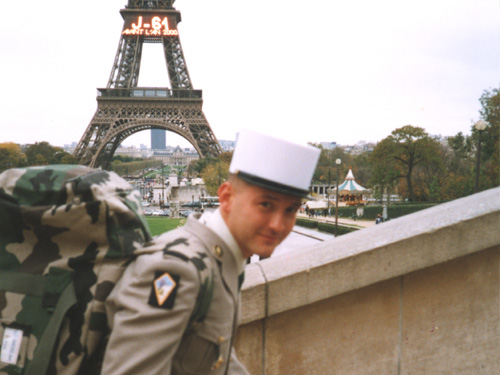What is the french foreign legion?
The French Foreign Legion was created by Louis Philippe on March 10, 1831, to support his war in Algeria, and to expeditiously rid France of unwanted foreigners, political enemies, and social outcasts.
Today, while most of its commissioned officers are French, the rest of the enlisted ranks is made up of foreign volunteers, from nearly every nationality in the world.
Legionnaires can choose to enlist under a pseudonym ("nom de guerre") and a declared citizenship. This disposition exists in order to allow people who want to turn a page in their life to enlist. French citizens can enlist under a declared, fictitious, foreign citizenship (Belgian, Swiss, or Canadian).
The Legion has always had a reputation for attracting criminals on the run and would-be mercenaries. In recent years, however, admission has been restricted and background checks are done on all applicants. Regardless, a man's past is never discussed.
After serving in the Legion for five years, the legionnaire is allowed to apply for French citizenship. Furthermore, a soldier harmed in combat for France is also allowed to apply for French citizenship.
Previously, the Legion was h eadquartered in North Africa. Until 1962 the Legion headquarters were stationed in Sidi-Bel-Abbes, Algeria. Nowadays, some units of the Legion are in Corsica or overseas possessions, while the rest is in the south of mainland France. Current headquarters are in Aubagne, just outside Marseille.
regiments
There are eight regiments:
- Mainland France
- 1st Foreign Cavalry Regiment (1e REC), based in Orange (armoured troops)
- 2nd Foreign Infantry Regiment (2e REI), based in Nîmes
- 1st Foreign Engineering Regiment (1e REG), based in Avignon-
- 2nd Foreign Engineering Regiment (2e REG), based on the Plateau d'Albion
- 1st Foreign Regiment (1e RE), based in Aubagne (Legion headquarters)
- 4th Foreign Regiment (4e RE) , based in Castelnaudary (training)
- 2nd Foreign Parachutist Regiment (2e REP), based in Calvi, Corsica
- French Overseas Territories
- 3rd Foreign Infantry Regiment (3e REI), based in French Guyana, South America
- 5th Foreign Regiment, based in French Polynesia
- The Detachment of the Foreign Legion (DLEM), in Mayotte, Africa
- 13th Demi-Brigade of Foreign Legion (13e DBLE), based in Djibouti, Africa.
battle history
It was in Mexico on 30 April 1863 that the Legion earned its legendary status. The small infantry patrol unit led by Capitaine Danjou numbering 62 soldiers and 3 officers was attacked and besieged by Mexican infantry and cavalry units numbering 3 battalions, and was forced to make a defense in the Hacienda Camarón. Despite the hopelessness of the situation they fought nearly to the last man. Danjou was mortally wounded in the defense of the hacienda, and the last of his men mounted a desperate bayonet attack. When the last three survivors were asked to surrender, they insisted that the Mexican soldiers allow them safe passage back home, to keep their flag, and to escort the body of the fallen Danjou. Upon seeing this, the Mexican commander commented, "these are not men, they are devils," and out of respect agreed to these terms.
Today the "Camerone Day" is a p rolific day of celebration for the Legion, when the wooden prosthetic hand of Capitane Danjou is brought on display.
During the Third Republic, the Legion played a major role in French colonial expansion. They fought in North Africa (where they established their headquarters at Sidi-Bel-Abbès in Algeria), Madagascar, and Indochina, where they participated in the celebrated defense of Tuyen Quang in 1885.
In World War I the Legion fought in many critical battles of the war, including the Battle of Verdun. The Legion was heavily decorated for its efforts in the war.
The Foreign Legion was heavily involved in World War II, playing a large role in the Middle East and the North African campaign. The 13th Demi-Brigade was deployed in the Battle of Bir Hakeim. Interestingly, part of the Legion was loyal to the Free French movement, yet another part was loyal to the Vichy government. A battle in Syria saw two opposing sides fight against each other in a short engagement, and later on the Vichy Legion joined its Free French brethren.
In Indochina, the Foreign Legion was involved in the defense of Dien Bien Phu and lost a large number of their men in the battle. Towards the desperate end of the battle, Legionnaires formed the bulk of the volunteer relief force which were delivered by parachute to the base.
The existence of the French Foreign Legion has led to a romantic view that it is a place for a wronged man to leave behind his old life to start a new one, but also that it is full of scoundrels and men escaping justice. This view of the Legion is common in literature, and has been used for dramatic effect in many movies, not the least of which are the several versions of Beau Geste. Much of that is still true today.
